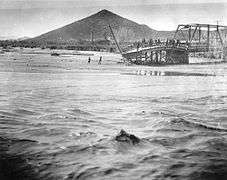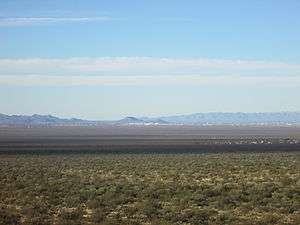Sentinel Peak (Arizona)
| Sentinel Peak | |
|---|---|
| "A" Mountain | |
.jpg) The "A" on Sentinel Peak | |
| Highest point | |
| Elevation | 2,901 ft (884 m) NAVD 88[1] |
| Prominence | 267 ft (81 m) [2] |
| Coordinates | 32°12′37″N 110°59′32″W / 32.210268833°N 110.992278114°WCoordinates: 32°12′37″N 110°59′32″W / 32.210268833°N 110.992278114°W [1] |
| Geography | |
 Sentinel Peak
| |
| Location |
City of Tucson Pima County, Arizona, U.S. |
| Parent range | Tucson Mountains |
| Topo map | USGS Tucson |
Sentinel Peak is a 2,897 ft (883 m) peak in the Tucson Mountains southwest of downtown Tucson, Arizona. The valley's first inhabitants grew crops at the mountain's base, along the Santa Cruz River. The name "Tucson" is derived from the O'odham Cuk Ṣon [tʃʊk ʂɔːn], meaning "[at the] base of the black [hill]". In the 1910s University of Arizona students used local basalt rock to construct a 160-ft-tall block "A" on the mountain's east face, near its summit, giving the peak its other name, "A" Mountain. The peak is part of a 272-acre park, the largest natural resource park in the City of Tucson.[3]
Early history
The fertile land at the base of Sentinel Peak was used for agriculture from circa 2000 BCE until the 1930s. Bedrock mortars found on the sides of the peak are believed to have been used to grind corn and mesquite beans into flour. In the 1690s the O'odham people living in the area were visited by Father Eusebio Francisco Kino, who established the nearby Mission San Xavier del Bac. After Presidio San Augustin del Tucson was constructed in 1775, sentinels were stationed on the peak to watch for raiding Apaches.
Geology
Sentinel Peak is made up of several layers of igneous rock representing various types of volcanic activity, though the mountain itself is not a volcano. It is one of a cluster of outcroppings at the eastern edge of the Tucson Mountains that are primarily the remnants of 20-30 million-year-old (Ma) lava flows that once extended west towards the Tucson Mountains and east into the Tucson Basin, where the city is now.[4] Erosion and faulting are responsible for the peak's conical shape.
The layer of rock at the peak of the hill is a basaltic andesite dating to 23-24 Ma. This caps a 30-36 meter-thick layer of tuff (compacted volcanic ash) above another layer of basaltic andesite, both dating to 26-28 Ma. Tuffs and andesite exposed at the base of the hill, on the south side, date to approximately 60 Ma.[4]
Volcanic ash and breccia, along with ancient lava beds, or lahars, can be also be found on the mountain, further evidence of a once active volcanic field that formed the Tucson Mountain range.
The Origin of the Name: Sentinel Peak
On October 3, 2016, in the Arizona Daily Star newspaper, historian David Leighton explained the origin of the name Sentinel Peak:
He wrote that in the very early days of Tucson, an Indian fortification was constructed at the top of a small mountain that would come to be called Sentinel Peak---also sometimes referred to as Picket Post Butte. This Indian fortification in time became known as the sentinel station because a sentinel or guard was posted there to watch for approaching enemies, likely Apache Indians. During the U.S. Civil War, armed guards or soldiers were posted at the sentinel station and a canvas was stretched across the stone fortification, to keep the sun from hitting directly on the men posted there.
By 1883, remains of the fortification is what existed at that point. The remains included, "A circular wall, about 3 feet thick and made of boulders, [that] enclosed an area about 8 feet in diameter. North of the circular structure was a small wall, roughly two feet high and about 10 feet long. To the east were traces of another, smaller circular wall."
In 1925, the remains of the fortifications still existed at the top of what by then was being called "A" Mountain although it is unknown what exactly was left at that point.
The origin of the name Sentinel Peak, according to Mr. Leighton, "comes from the sentinel station and the sentinel stationed there." [5]
The "A"
After Arizona football's 7–6 victory over Pomona in 1914, a civil engineering student on the team convinced one of his professors to make a class project of the survey and design for a huge block "A" on Sentinel Peak. Students carried the project to completion on March 4, 1916, when the 70 ft (21 m) wide, 160 ft (48 m) tall "A" was whitewashed on the east side of the peak. The basalt rock used in construction of the "A" was hauled from a quarry at the mountain's base which supplied stone for many foundations and walls throughout Tucson, including the wall surrounding the University of Arizona campus.[6]
The "A" has traditionally been painted white. On March 23, 2003, four days after the start of the Iraq War, it was painted black in protest. Two weeks later, following much public debate, the Tucson City Council resolved to have the "A" painted red, white, and blue in honor of American troops. A decade later the council decided to restore it to its traditional white.[7] The "A" has on occasion been painted green for St. Patrick's Day.[8]
Arizona State University has a more recently-created "A" Mountain (Tempe Butte) near the school's football stadium. During the week of the Arizona-ASU Territorial Cup game, rival fans and students have tried and at times succeeded in painting the "A" of the opposing school with their own school colors.
Gallery
- Dense stands of saguaros at the base of Sentinel Peak
 Sentinel Peak, standing behind a wrecked bridge along the Santa Cruz River during the flood of 1915
Sentinel Peak, standing behind a wrecked bridge along the Santa Cruz River during the flood of 1915 "A" Mountain (right) and Tumamoc Hill (left) in the distance, looking west across the Tucson Valley
"A" Mountain (right) and Tumamoc Hill (left) in the distance, looking west across the Tucson Valley Tucson as seen from Sentinel Peak
Tucson as seen from Sentinel Peak
See also
| Wikimedia Commons has media related to Views from Sentinel Peak (Arizona). |
- List of mountains and hills of Arizona by height
- University of Arizona
- List of hillside letters in Arizona
References
- 1 2 "Warner". NGS data sheet. U.S. National Geodetic Survey. Retrieved 2016-08-20.
- ↑ "Sentinel Peak, Arizona". Peakbagger.com. Retrieved 2016-08-20.
- ↑ Davis, Tony (August 5, 2013). "Sentinel Peak Park gets an upgrade". Arizona Daily Star.
- 1 2 Spencer, J.E.; Moore, E.M.; and Trapp, R.A. (February 2003), Bedrock Geolocgic Map of Sentinel Peak (A-Mountain) and Tumamoc Hill, Pima County, Arizona (PDF), Arizona Geological Survey
- ↑ David Leighton, "Street Smarts: Tale of road up "A" Mountain includes murder, adultery and dirty deals," Arizona Daily Star, Oct. 3, 2016
- ↑ "UA History & Traditions—"A" Mountain". arizona.edu. The University of Arizona.
- ↑ Steller, Tim (April 14, 2013). "Big 'A' will revert to white, so let's color this battle over". Arizona Daily Star.
- ↑ "Two businesses step in, redo 'A' on Sentinel Peak". Arizona Daily Star. April 6, 2008.